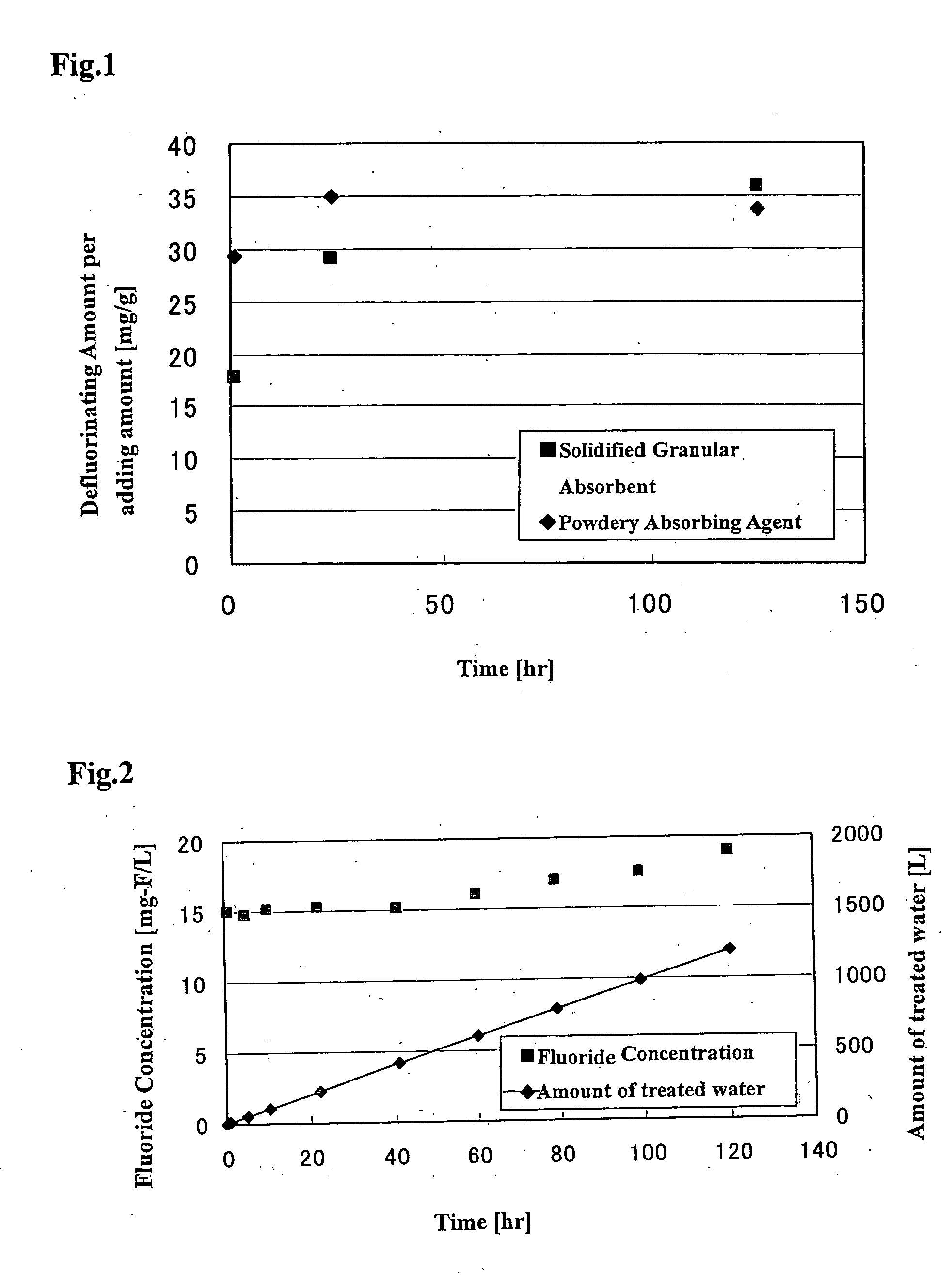Method of producing remover and remover
- Summary
- Abstract
- Description
- Claims
- Application Information
AI Technical Summary
Benefits of technology
Problems solved by technology
Method used
Image
Examples
example 1
[0034] 1 part by weight of ethylcellulose, 5 parts by weight of ethanol, and 5 parts by weight of cyclohexane were mixed to prepare a high-polymer-doped solution. A powdery absorbing agent (mean particle diameter of 10 μm) mainly consisting of calcium hydroxide was used as a removing agent. 5 g of the powdery absorbing agent was kneaded with 10 g of the high-polymer-doped solution. A mixture thus obtained was dried at 105° C. for 24 hours and was then pulverized into grains of 1-2 mm in diameter.
[0035] 0.5 g of solidified granular absorbent thus produced was added to 200 mL of potassium fluoride solution containing 44.8 mg-F / L. Changes in fluoride concentration were measured. The changes with time in fluoride concentration and turbidity (absorbance of 660 nm) after 125 hours are shown in Table 1.
example 2
[0043] 1 part by weight of accetylcellulose, 10 parts by weight of acetone, and 10 parts by weight of formamide were mixed to prepare a high-polymer-doped solution. A powdery bentonite-series absorbing agent (mean particle diameter of 100 μm) containing rare earth metal as a removing agent was used. 5 g of the powdery bentonite-series absorbing agent was kneaded with 5 g of the high-polymer-doped solution. A mixture thus obtained was dried at 105° C. for one week and was then pulverized into grains of 1-2 mm in diameter.
[0044] 0.05 g of solidified granular absorbent thus produced was added to 200 mL of sample liquid prepared by adding sodium dihydrogen phosphate into city water to have phosphoride concentration of 5.05 mg-P / L. Changes in phosphoride concentration were measured. The phosphoride absorptive capacity per unit weight and turbidity (absorbance of 660 nm) after 24 hours are shown in Table 2.
example 3
[0047] 1 part by weight of accetylcellulose, 10 parts by weight of acetone, and 10 parts by weight of formamide were mixed to prepare a high-polymer-doped solution. A bentonite-series absorbing slurry containing rare earth metal containing 50% by weight of water as a removing agent was used. 10 g of the bentonite-series absorbing slurry was kneaded with 5 g of the high-polymer-doped solution. A mixture thus obtained was dried at 105° C. for three days and was then pulverized into grains of 1-2 mm in diameter.
[0048] 0.05 g of solidified granular absorbent thus produced was added to 200 mL of sample liquid prepared by adding sodium dihydrogen phosphate into city water to have phosphoride concentration of 2.70 mg-P / L. Changes in phosphoride concentration were measured. The phosphoride absorptive capacity per unit weight and turbidity (absorbance of 660 nm) after 48 hours are shown in Table 3.
PUM
| Property | Measurement | Unit |
|---|---|---|
| Percent by mass | aaaaa | aaaaa |
| Percent by mass | aaaaa | aaaaa |
| Diameter | aaaaa | aaaaa |
Abstract
Description
Claims
Application Information
 Login to View More
Login to View More - R&D
- Intellectual Property
- Life Sciences
- Materials
- Tech Scout
- Unparalleled Data Quality
- Higher Quality Content
- 60% Fewer Hallucinations
Browse by: Latest US Patents, China's latest patents, Technical Efficacy Thesaurus, Application Domain, Technology Topic, Popular Technical Reports.
© 2025 PatSnap. All rights reserved.Legal|Privacy policy|Modern Slavery Act Transparency Statement|Sitemap|About US| Contact US: help@patsnap.com

